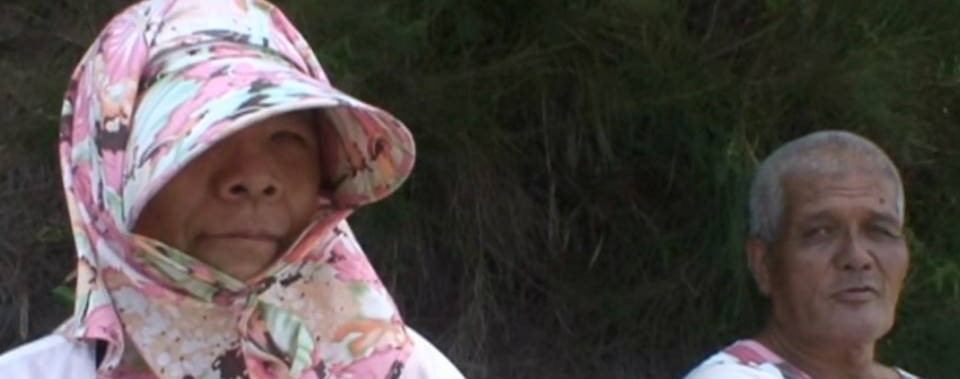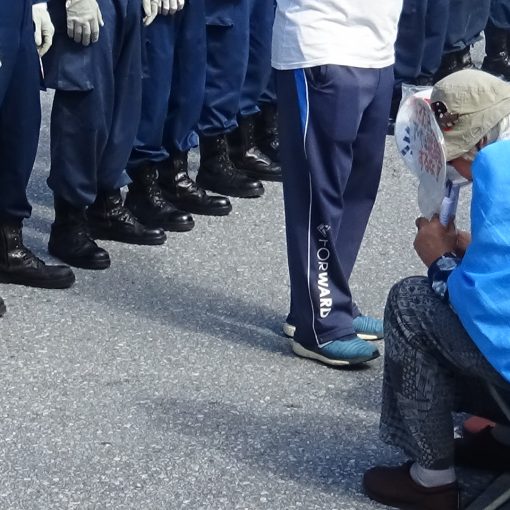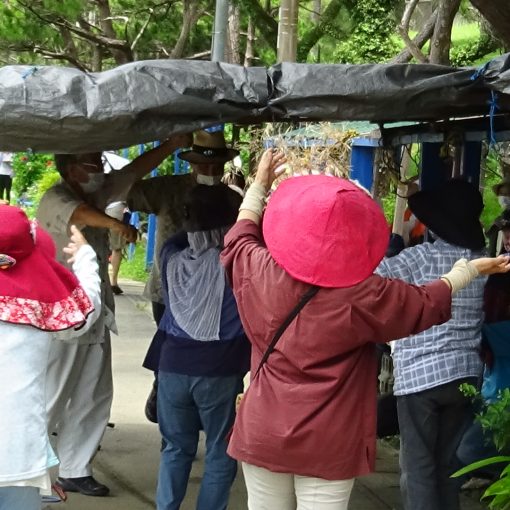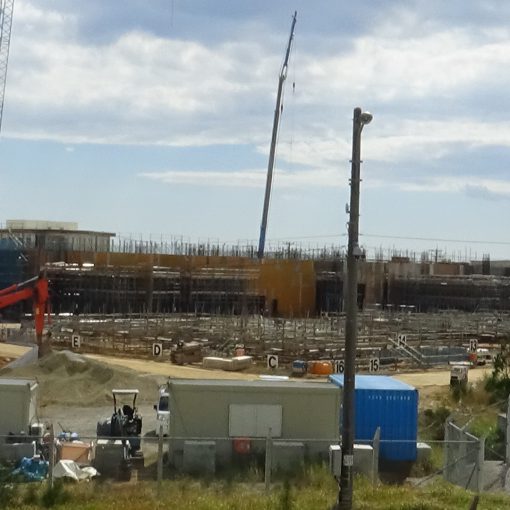Ms. Yoshiko Higa (73 years old) has a reserved position for the protest, in the north of the delivery truck line in front of the gate. Teijo, her husband, always prepares her chair. Once the protest rally begins, she listens to participants’ voices, footsteps of the riot police, engine sounds of dump trucks, etc. to feel out the situation. As soon as chants start, she joins in.
They come to Henoko almost every day together. The protestors are familiar with the scene where Teijo guides his visually impaired wife by the hand at the protest site in Henoko. Yoshiko repeatedly says that now is the time to fight against the new base construction to prevent wars for her children and grandchildren.
She had a high fever due to measles and lost her eyesight at two years of age. “My mother looked for a doctor, carrying me on her back, but she could not find one. Those were the days when no drugs were available, and doctors were scarce,” said she.
Her father faced readjusting problems after coming back home from the war. Abuse from her father and elder brother in childhood left scars in her heart. Her mother tried her best to protect her, but Yoshiko could not help but often undergo the violence. “I had suffered a lot in my childhood days, but now I am not sad because everyone is kind here. I can forget the hardest memory when I come here,” says she.
Teijo proposed to her when she lived in Henoko. Teijo, her childhood friend, is a fisherman. Since their childhood, he played with her and took care of her. Recalling their childhood, Yoshiko smiled, “He was and is compassionate.”
Yoshiko was the one to bring it up to go to Henoko for protest. She knows very well that the war will cast out people with disabilities. She, therefore, thinks that she would keep on protesting now for future generations.
Two round trip bus tickets from Kin to Henoko cost 2,360 yen per day, not cheap. Despite that, Yoshiko calls her husband and starts to Henoko together just at about 6:00 a.m. “She is a real fighter. She has Ryukyu soul,” says Teijo with a smile, standing a little away from her.

(In front of Camp Schwab Gate)
It was hot, at almost 30℃ of temperature, this day. Twenty-five citizens resumed the sit-in, which immediately caused traffic congestion of over 50 trucks on the national road, including concrete mixers. Twenty riot police officers came and urged the protesters to move away, but some protesters resisted. It took about 10 minutes before the gate opened.
A protest march went on in front of the gate after the delivery trucks entered the base. The protestors raised voices, “The Okinawa Defense Bureau should comply with instructions of the prefectural government,” and “No concrete for the sea.”
Delivery by 161 vehicles was made in three convoys during the day. The Camp Schwab reported three new cases of COVID-19 infection.



(Ryukyu Cement Awa Pier)
About 20 citizens continued to protest against dump truck drivers, dividing into two groups at the pier entrance and exit. Usual aggressive control of a riot police leader, H, who takes command at the exit, was prominent. He forbade people from crossing the road for almost ten minutes to let the dump trucks coming out of the gate. He responded to our protest, “The dump trucks have the right of way here.” I wonder if he understands the Traffic Law. His control goes too far over the edge. He has had frequent troubles with the citizens. Ten GoGo Drive members delayed the run of dump trucks by driving around on the road. In the afternoon, the riot police blocked one lane of the road to interrogate one of the GoGo Drive members, showing their excessive concern over control.
They loaded 778 loads of soil and sand to four carriers, working almost to 8 p.m.


(Motobu Shiokawa Pier)
No loading soil and sand due to climate instability with high waves.
Number of dump trucks to date and percentage against the total
The estimation calculated on the basis of the number of ruckloads serves only as a reference.
Number of dump trucks which made delivery from December 2018 to the end of December 2019 114,601(1.39%)
| 31(Sat) | Nov.2(Mon) | 3(Tue) | 4(Wed) | 5 (Thu) | 6(Fri) | |
| Awa | 756 | 778 | ||||
| Shiokawa | 0 | 0 |
| Number of dump trucks ※ |
Weightt of earth/sand
※① |
Converted to volume
※② |
Volume per Total
※③ |
| 272,208 | 1,361,040t | 680,520㎥ | 3.369% |
※ Cumulative since Dec. 1, 2019
※① Calculated by assuming that the average truckload per dump truck would be 5 tons
※② Calculated by assuming that a specific weight of soil/sand set to be 2
※③ Percentage against 20.200.000m3, the total volume of earth and sand required for the landfill.





